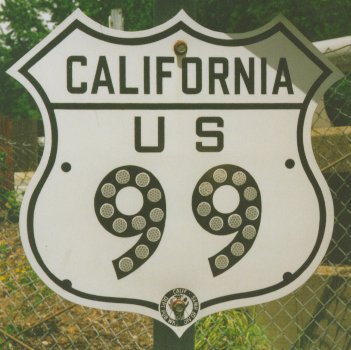 |
| Photo: www.routemarkers.com |
Rent a 1950s vintage Chrysler with tail fins and meet me at the corner of US 99 and US 66.
Can’t find it on Google Maps? That’s because both roads have been lost to history for nearly 50 years. But in case you’re wondering, that defunct crossroads is now the intersection of Figueroa Street and San Fernando Road just north of Downtown Los Angeles.
US routes - those numbered roads signed with distinctive black-and-white federal shields - were our primary long distance highways during the first half of the 20th century. The US Department of Agriculture and American Association of State Highway Officials dreamed up this nationwide system of routes in the mid 1920s. Most of the roads were already in place; the route numbers simply provided standardized, continuous route identities for cross-country navigation. North-south routes were given odd numbers that got higher as you moved west (opposite of today’s interstates); east-west routes had even numbers that increased as you moved south; shorter spur routes had three-digit numbers.
Many of the routes - built and maintained largely by state highway departments, not the federal government - still exist today. US 1 still runs from Fort Kent, ME to Key West, FL; US 30 from Atlantic City, NJ to Astoria, OR; and US 50 from Ocean City, MD to Sacramento, CA.
But in a fate scripted into many a motion picture (including Disney’s “Cars”), US routes relinquished their role as our nation’s primary through routes in the 1950s, courtesy of President Eisenhower’s interstate highway system. Some interstates were built on completely new alignments through the countryside, sparing from demise routes like US 20, 30, 41 and 50. But in many other cases, the most logical place to build an interstate was atop, or next to, a nicely established two-lane road connecting cities and towns. These latter freeways usually resulted in dead US routes.
 |
| Route 66 on Adams Street in Chicago. Photo: author |
US 99 once ran through the west coast’s inner valleys from Canada to Mexico, passing through Seattle, Portland, Sacramento and Los Angeles. It has been mostly replaced by Interstate 5, but those portions that were not gobbled up are now signed as State Highway 99. This includes the Alaskan Way Viaduct and Aurora Avenue in Seattle, Highways 99E and 99W in Oregon’s Willamette Valley, and the Golden State Freeway in the Central Valley of California.
Other dead US routes include:
- US 32, which is now I-80 between Chicago and Council Bluffs, IA;
- US 48, which is now I-68 between Hancock, MD and Morgantown, WV (a fairly recently dead US route); and
- US 94, which was simply switched to US 41 between Naples and Miami, FL.
 |
| Photo: What's Up, Chuck? |
Then there’s my favorite dead US route: 666. YEAH! [Flashes devil horns]. But this highway to hell was not replaced by an interstate. Far from it. It was renumbered by the state highway departments of Utah, Colorado and New Mexico, in response to superstitious claims about unusually high accident and fatality rates. (It apparently wasn’t the miles of uninterrupted dark desert that was killing people). Today, that route is unremarkable US 491, from Gallup, NM to Monticello, UT. I’m glad I got to see Route 666 on a family vacation to the Four Corners back in the 90’s, when it was still devilish.
If you really want to geek out on the details of dead US routes, check out us-highways.com, or look up individual routes on Wikipedia. Many of them would make great road trips, 50s Chrysler or otherwise.
No comments:
Post a Comment